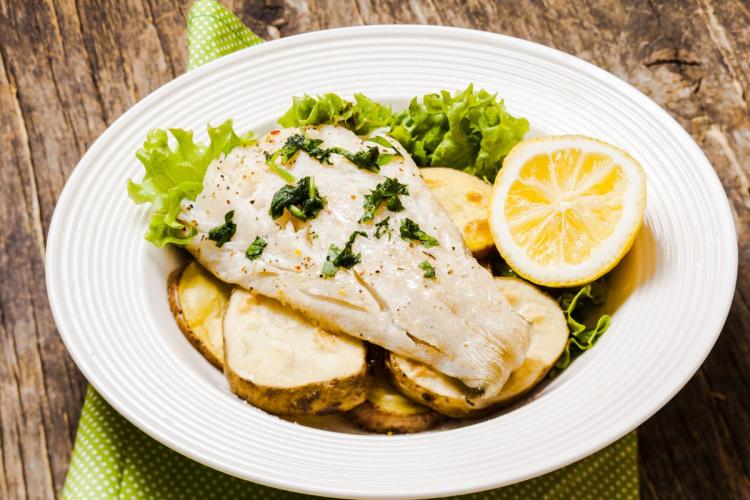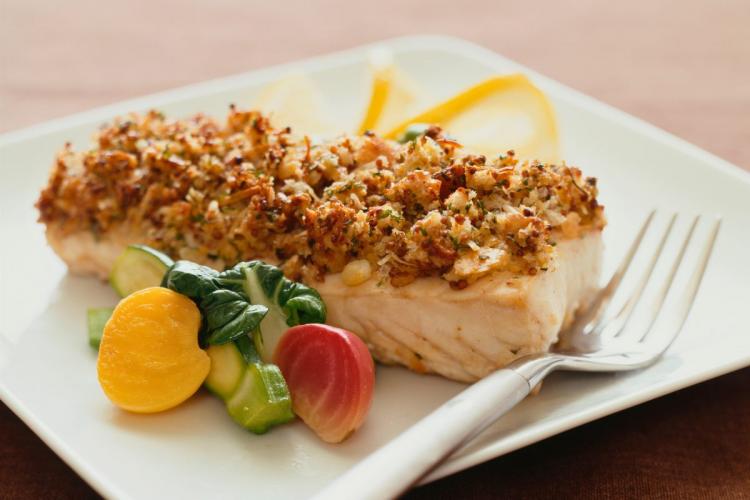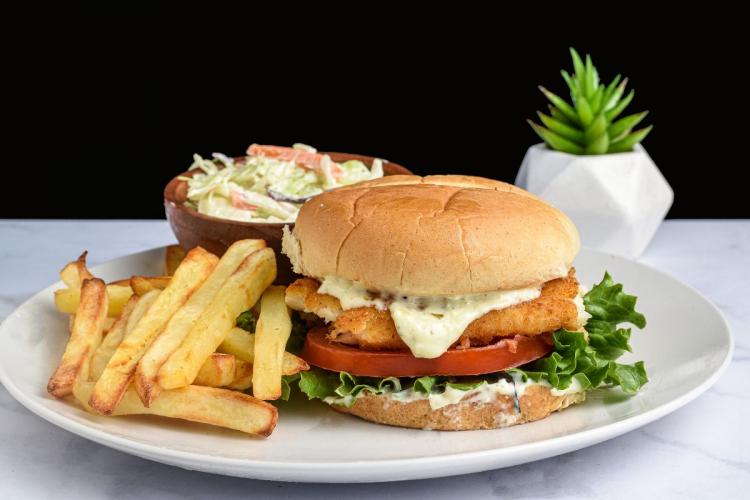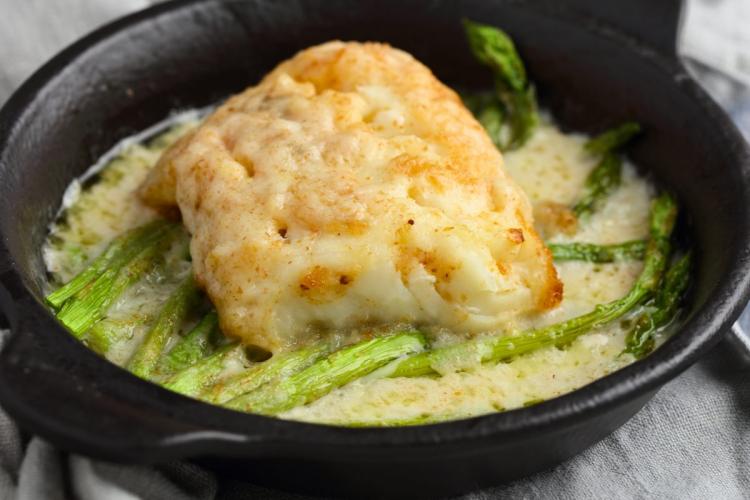Perfectly baked haddock (or cod)
Delicious recipes and essential cooking times.
Haddock's characteristics make it particularly well-suited for baking. Its firm texture ensures that it remains intact and doesn't disintegrate in the oven, a common plight with more delicate fish. Moreover, the gentle cooking method of baking is perfect for preserving the moistness of haddock, preventing it from drying out, which can often be the case with more robust cooking techniques. Baking also allows for the infusion of flavors, whether it's a simple herb seasoning or a more elaborate marinade, enhancing the natural taste of the fish without overpowering it.
Preparing Haddock for Baking
Selecting the best haddock fillets
The journey to a perfect baked haddock dish begins at the fish counter or your local seafood market. Here are some tips to ensure you select the best quality haddock fillets:
- Freshness is Key: Look for haddock that smells fresh and mild, not fishy. The flesh should be firm to the touch and spring back when pressed.
- Appearance Matters: Fresh haddock fillets should have a bright, clean appearance, without any discoloration, dryness, or sliminess.
- Skin-On or Skin-Off: You can choose between skin-on or skin-off fillets. Skin-on can help the fillet hold together better during baking and can be easily removed after cooking if desired.
- Size Consistency: Try to select fillets that are consistent in size and thickness to ensure even cooking.
Preparing haddock for baking
Once you have your haddock fillets, proper preparation is crucial for achieving the best baking results. Here's how to prepare your haddock for the oven:
Rinsing and patting dry: Begin by rinsing the fillets under cold water to remove any lingering scales or debris. Then, pat them dry thoroughly with paper towels. This step is important to prevent excess moisture during baking, which can affect the texture.
Trimming: If necessary, trim any uneven edges or remove small bones that may have been missed. Kitchen tweezers can be very handy for this task.
Seasoning: The mild flavor of haddock makes it a perfect canvas for a variety of seasonings. You choose, either keep it simple with salt, pepper, and maybe a squeeze of lemon; or get creative adding herbs, spices, or using marinades. Remember, haddock absorbs flavors well, so don’t overdo it.
Marinating (optional): For added flavor, you can marinate the haddock fillets. However, due to its delicate texture, a short marinating time (15-30 minutes) is sufficient. Acidic marinades with lemon juice or vinegar should be used cautiously as they can start "cooking" the fresh fish, if left for too long.
Preparing the baking dish: Lightly grease your baking dish or line it with parchment paper for easy clean up. This prevents the fish from sticking and helps in retaining moisture.
Portioning: If your fillets are large, consider cutting them into portion-sized pieces. This ensures that each piece cooks evenly and makes serving easier.
Bringing fish filets to room temperature: Let the fillets sit at room temperature for about 10-15 minutes before baking. This step helps in cooking the fish more evenly.
By following these steps, your haddock will be perfectly prepped and primed for the oven, ready to transform into a delicious, flaky, and flavorful meal.
Baked haddock recipes
Baked haddock is a dish that offers both simplicity and versatility. Whether you're in the mood for something classic or looking to experiment with new flavors, these recipes cater to a range of tastes and preferences. Each recipe is designed to be straightforward, ensuring even those new to cooking fish can achieve delicious results.
Classic lemon and herb baked haddock
This is a great baked haddock recipe and it is so easy. All you need is haddock fillets, olive oil or butter, lemon juice, dried herbs and garlic. Sounds delicious.
Lemon and herb baked haddock recipe
Parmesan crusted haddock
This baked haddock recipe can easily be a baked cod recipe, or a baked hake recipe. With a delicious parmesan crust, it's impossible to go wrong. The Parmesan cheese adds a bit of extra flavor and saltiness to this tasty dish.
Parmesan crusted baked haddock recipe
Mediterranean style baked haddock
Baked fish with Mediterranean vegetables is absolutely delicious and healthy. Use cod, haddock or other white fish.
Mediterranean style baked haddock recipe
Butter breadcrumb crusted baked haddock
A butter breadcrumb topping is a classic and delicious way to enhance the flavor of New England baked haddock. A crunchy topping like this one adds a delightful texture and richness to the mild taste of the fish.
Butter breadcrumb crusted baked haddock recipe
These recipes showcase the versatility of haddock, offering a range of flavors from the comforting classic to the more adventurous. Each recipe is crafted to enhance the natural taste of haddock while keeping the preparation and cooking process as straightforward as possible.
Tips for perfect baking
Baking haddock to perfection is an art that involves more than just following a recipe. Understanding the factors that affect cooking time and knowing how to avoid common pitfalls like overcooking or undercooking are key. Additionally, choosing the right accompaniments can elevate your dish to a new level. Here are some essential tips to help you master the art of baking haddock.
Factors affecting cooking time
Thickness of the fillet
The thickness of your haddock fillet is the primary determinant of cooking time. Thicker fillets require more time in the oven compared to thinner ones. Always adjust cooking times based on the thickness of your fish.
Oven variations
Not all ovens are created equal. Variations in temperature calibration can affect cooking times. If you know your oven runs hot or cool, adjust the cooking time or temperature accordingly.
Convection ovens, which circulate hot air, typically cook food faster and more evenly. If using a convection oven, you may need to reduce the cooking time or temperature.
Avoiding overcooking or undercooking
Use a thermometer
The most reliable way to check for doneness is by using an instant-read thermometer. The ideal internal temperature for cooked haddock is 145°F (63°C). Insert the thermometer into the thickest part of the fillet to get an accurate reading.
Visual inspection
Look for signs of doneness like flaky texture and opaque color. The edges should be slightly golden, and the fish should easily flake with a fork. The texture of the white fish should be moist, not dry or rubbery.
Timely checks
Start checking for doneness a few minutes before the recipe's suggested time, especially if you're trying it for the first time.
Additional tips for baking haddock
- Preheat the oven: Always start with a preheated oven for even cooking.
- Room temperature fillets: Let the fillets sit at room temperature for about 10-15 minutes before baking for more even cooking.
- Avoid overcrowding: Place fillets in a single layer with some space in between to ensure even heat distribution.
- Basting: If using a sauce or marinade, basting halfway through can add moisture and flavor.
- Resting time: Let the thicker pieces of haddock rest for a few minutes after baking. This allows the juices to redistribute, ensuring a moist fillet. For thin fillets, serve immediately.
By following these guidelines, you can confidently bake haddock at the right temperature and for the correct duration, achieving a perfectly cooked fish that's both flavorful and satisfying.
Cooking times and temperatures for baked haddock
What temperature should the best baked haddock be? Achieving perfectly baked haddock involves understanding the right balance of cooking time and temperature. This section addresses the key questions surrounding these aspects, ensuring your haddock turns out deliciously flaky and moist every time.
Cooking haddock at 350°F (175°C)
Plain fillets
- Thickness: Thin fillets (less than 1 inch)
- Time: 15-20 minutes
- Tips: Fillets should be placed in a single layer in the baking dish. If using a marinade or sauce, baste halfway through cooking.
Breaded or crusted fillets
- Thickness: Medium fillets (up to 1 inch)
- Time: 20-25 minutes
- Tips: Breaded fillets may take slightly longer due to the additional layer. Check for a golden-brown crust as a sign of doneness.
Cooking haddock at 375°F (190°C)
Plain fillets
- Thickness: Medium to thick fillets (1 inch or more)
- Time: 18-25 minutes
- Tips: Thicker fillets require more time. Ensure the center of the fillet reaches the proper temperature without drying out the edges.
Breaded or crusted fillets
- Thickness: Medium to thick fillets
- Time: 25-30 minutes
- Tips: A higher temperature helps achieve a crispier crust. Keep an eye on the fillets to prevent burning.
How to store cooked haddock and reheat it later
Storing and reheating baked haddock properly is crucial to maintain its flavor and texture. Here's how you can do it:
Storing baked haddock
Cool down: Allow the baked haddock to cool to room temperature. Do not leave it out for more than 2 hours to avoid bacterial growth.
Refrigerate promptly: Transfer the cooled haddock to an airtight container. If you have a large quantity, consider dividing it into smaller portions. This helps the fish cool more quickly and makes reheating easier.
Refrigeration: Store the container in the refrigerator. Baked haddock can be safely stored in the fridge for up to 3 days.
Freezing (optional): If you need to store the haddock for a longer period, you can freeze it. Wrap the fish tightly in aluminum foil or freezer wrap, or place it in a freezer bag. Properly stored, it can last for up to 4 months in the freezer. However, be aware that freezing may slightly alter the texture of the fish.
Reheating baked haddock
Thawing (if frozen): If the haddock is frozen, thaw it in the refrigerator overnight. Avoid thawing at room temperature as it can lead to bacterial growth.
Oven reheating (recommended): Preheat your oven to 275°F (135°C). Place the haddock on a baking sheet and cover it loosely with aluminum foil. This helps to keep the fish moist. Reheat for about 10-15 minutes, or until the internal temperature reaches 145°F (63°C). The low and slow method of reheating in the oven helps to preserve the texture and moisture of the fish.
Microwave reheating: Although not ideal, you can use a microwave for convenience. Place the haddock on a microwave-safe dish and cover it with a damp paper towel. This helps to keep the fish moist. Use a low power setting and heat in short intervals of 30 seconds, checking regularly until the desired temperature is reached. Be cautious as microwaves can unevenly heat and potentially overcook the fish.
Avoid overheating: Whether using an oven or microwave, be careful not to overheat the haddock, as this can dry it out and affect its texture.
By following these storage and reheating guidelines, you can enjoy your baked haddock while maintaining its quality and flavor.
Pairing with Side Dishes
What goes with baked haddock? By considering these factors and tips, you'll be well on your way to baking haddock that is consistently delicious and perfectly cooked. Remember, the best dishes come from not just following a recipe, but understanding the nuances of cooking.
You do not always need to present the baked fish in a plate. Baked haddock in breadcrumbs is great in a sandwich.
Complementary flavors
Haddock's mild flavor pairs well with a variety of side dishes. Choose sides that complement rather than overpower the fish.
Vegetable sides
Roasted or steamed vegetables like asparagus, broccoli, or a medley of summer vegetables can add color and nutrition to your plate.
Starches
For a heartier meal, serve baked haddock with rice, quinoa, or a baked potato. These starches absorb the flavors of the fish and any accompanying sauces well.
Salads
A light, crisp salad, perhaps with a lemon vinaigrette, can balance the richness of the fish.
Sauces and garnishes
Lemon wedges, tartar sauce, or a dill yogurt sauce can enhance the flavor of the haddock. Fresh herbs like parsley or chives also make great garnishes.
Baking haddock
Baking haddock can bring up several questions, especially for those new to cooking fish. Below are answers to some of the most frequently asked questions to help you achieve the best results.
How long do you bake haddock fillets?
The baking time for haddock fillets depends on their thickness and the oven temperature. At 350°F (175°C), thin fillets (less than 1 inch) typically take 15-20 minutes, while thicker fillets may need 20-25 minutes. At 375°F (190°C), allow 18-25 minutes for medium to thick fillets. Always check for doneness by ensuring the fish reaches an internal temperature of 145°F (63°C) and flakes easily with a fork.
How long to cook breaded haddock in the oven?
Breaded haddock usually takes slightly longer to cook than plain fillets due to the additional layer. At 350°F (175°C), bake breaded haddock for about 20-25 minutes. If baking at 375°F (190°C), it may take 25-30 minutes. Look for a golden-brown crust and check that the fish is cooked through.
How can I tell if haddock is fully cooked?
Haddock is fully cooked when it reaches an internal temperature of 145°F (63°C). Visually, the fish should be opaque and flake easily with a fork. The edges should be slightly golden, and the texture should be moist, not dry or rubbery.
Can I bake haddock from frozen?
Yes, you can bake haddock straight from frozen. However, the cooking time will be longer. Bake frozen haddock at 425°F (220°C) for 20-25 minutes. Check for doneness using a thermometer or by ensuring it flakes easily.
Should I cover haddock when baking?
It's not necessary to cover haddock when baking, especially if you're aiming for a slightly crispy top. However, if you find the fish is drying out, you can loosely cover it with foil.
What temperature should haddock be cooked at?
Haddock can be baked at various temperatures, but the most common are 350°F (175°C) and 375°F (190°C). The choice of temperature can depend on the recipe and the desired texture of the fish.
Is it better to bake haddock in foil or open in a dish? Covered or uncovered?
Baking haddock in foil can create a steaming effect, resulting in moist fish. Baking it open in a dish, especially if it's breaded or seasoned, can give a more textured exterior. The method can depend on personal preference and the specific recipe.
Your baked haddock journey
Choose a baked haddock recipe to start. Baked haddock is a dish that combines simplicity, health, and exquisite taste. We have gone from understanding the unique qualities of haddock, with its flaky texture and mild flavor, to selecting and preparing the perfect fillets, we've covered the essentials to set you up for baking success.
We delved into a few recipes, each offering a unique twist on this versatile fish. Whether it's the classic lemon and herb, the rich Parmesan crust, the Mediterranean-inspired version, or the sweet and tangy honey mustard glaze, these fish recipes are designed to cater to diverse palates and occasions.
The importance of mastering cooking times and temperatures cannot be overstated, and we've provided detailed guidelines for different oven settings and fillet types. Remember, the thickness of the fillet and the individual quirks of your oven play crucial roles in determining the perfect baking duration.
To ensure your haddock is baked to perfection, we've shared tips on avoiding overcooking or undercooking, and suggested a range of accompaniments and side dishes to complement your fish.
Finally, we addressed common FAQs, offering clear, concise answers to help you navigate any uncertainties you might encounter in your baking journey.
Now, it's your turn to take these insights and recipes into your kitchen. We encourage you to experiment with the flavors and techniques discussed, and most importantly, to enjoy the process. Baking haddock can be a delightful culinary adventure, and we hope this guide inspires you to create memorable meals.
Share your experiences, successes, and even the learning moments in the kitchen. Your feedback and stories can inspire others and contribute to a community of haddock enthusiasts. Happy baking!




